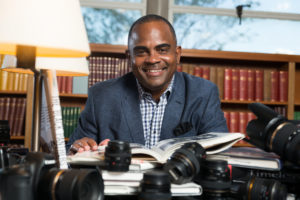
Teaching in the Visual Age: Seeing the Light of Teaching
When I got my PhD in 1997 and began my teaching career we were just being introduced to PowerPoint. I like many others remember those days which have long since gone. Over my career we have moved from the use of PowerPoint to teaching in classrooms where students have laptops, tablets and phones. Students are engaging life through the screen. What does it mean to teach in an age where our students are being shaped by what they have in their hands? How do we focus our teaching in light of our student’s reality of living in an age where they are learning via moving and still images? How does our teaching align with how they see the world via Instagram, YouTube, TikTok and Facebook? We live in a world where, “…three hundred hours of YouTube video are uploaded every minute. Six billion hours of video are watched every month on the site, one hour for every person on earth. The 18–34 age group watches more YouTube than cable television. (And remember that YouTube was only created in 2005.)[1] “Every two minutes, Americans alone take more photographs than were made in the entire nineteenth century.”[2] We have become a world of image makers and these images have become our primary way to engage the world, learn about the world and our students are visual learners and much of our teaching is literate and oral. I propose that we embrace the visual world and learn as our students learn so that we can become more effective pedagogues.
In his book How to See the World, Nicholas Mirzoeff articulates aspects of the contemporary visual age and provides insights about the history of visual media since 1930:
As early as 1930, an estimated 1 billion photographs were being taken every year worldwide. Fifty years later, it was about 25 billion a year, still taken on film. By 2012, we were taking 380 billion photographs a year, nearly all digital. One trillion photographs were taken in 2014. There were some 3.5 trillion photographs in existence in 2011, so the global photography archive increased by some 25 percent or so in 2014. In that same year, 2011, there were 1 trillion visits to YouTube. Like it or not, the emerging global society is visual. All these photographs and videos are our way of trying to see the world. We feel compelled to make images of it and share them with others as a key part of our effort to understand the changing world around us and our place within it.[3]
So, what does this mean for me and what does it mean for us? For me it has meant a complete shift in how I teach. I have moved from thinking first about lecture, words, reading and content to thinking visually. How will I engage the eyes of my students so that I can touch the mind of my students? How can I help them see what we are thinking about in this course as it lives in the world as an image that expands their imagination? Imagining the image expands the imagination of students who live in a world of images. The image becomes the lens by which my students enter this world on a daily basis therefore I start with them in my viewfinder. I see them as they see the world and because this is their starting point it is my starting point. I am teaching with them in sight, I see them looking at their phones, I see what they see and as they see so that I can teach in the visual language that they understand. My students sleep with their phones beside their beds and before they brush their teeth in the morning, they pick up their phones and start their day looking at images. I want my courses and my content to be on their home-screens. This is the world in which we live, this is the age in which we are called to teach. I had to change how I see my teaching so that my students could see what I am trying to get them to engage. This has been a major shift for me. It called me to go back go to school to learn how to see so that I could become an effective teacher in the visual age. I talk about my shift and embrace of the world in which we live in the short video that accompanies this Blog. In this video we are celebrating my installation in an endowed chair. The video speaks to the shift I have made, and I invite you to consider. What does it look like to teach in the visual age (pun intended)?
Teaching in the Visual Age: Dr. Ralph Basui Watkins from Ralph Watkins on Vimeo.
[1] Mirzoeff, Nicholas. How to See the World (4). Basic Books. Kindle Edition.
[2] Mirzoeff, Nicholas. How to See the World (4). Basic Books. Kindle Edition.
[3] Mirzoeff, Nicholas. How to See the World (4-5). Basic Books. Kindle Edition.
*Original Blog published on December 11, 2019
Leave a Reply